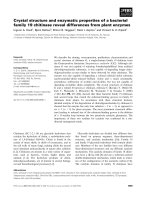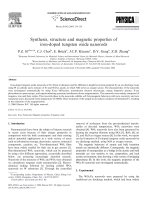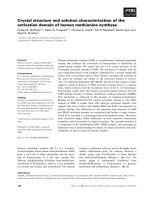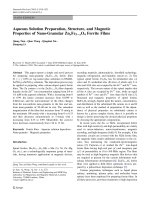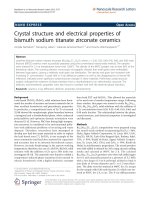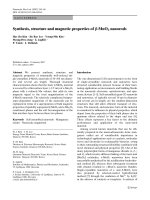- Trang chủ >>
- Khoa học tự nhiên >>
- Vật lý
THE INFLUENCE OF COBALT ON CRYSTAL STRUCTURE AND MAGNETIC PROPERTIES OF nimnsbb2 HEUSLER ALLOYS
Bạn đang xem bản rút gọn của tài liệu. Xem và tải ngay bản đầy đủ của tài liệu tại đây (1.62 MB, 48 trang )
VIETNAM NATIONAL UNIVERSITY, HANOI
VNU UNIVERSITY OF SCIENCE
FACULTY OF PHYSICS
Vu Thi Huong
THE INFLUENCE OF COBALT ON CRYSTAL
STRUCTURE AND MAGNETIC PROPERTIES OF
NiMnSbB2 HEUSLER ALLOYS
Submitted in partial fulfillment of the requirements for
the degree of Bachelor of Science in International Physics
( International Standard Program)
Supervisor: Prof.Dr. Luu Tuan Tai
Hanoi - 2016
Thesis
Vu Thi Huong
ACKNOWLEDMENT
First, I would like to say my sincere thanks to our teachers in the
Department of Low Temperature and Faculty of Physics, Hanoi university of
science, Vietnam National university, who have equipped me with valuable
knowledge in the past and help me a lots to have the best result.
I would like to express my sincere thanks to Professor Luu Tuan Tai
who has enthusiastically instructed me to complete the thesis.
After all, I would like to send many thanks to my friends, my colleges
and my closed people who did not hesitate to spend time on support, give
comments and help me during my study.
Hanoi, May 25th,2016
Huong
Vu Thi Huong .
Thesis
Vu Thi Huong
List of Figures
Figure 1.1 – Schematic picture that shows the two basic processes of
the magnetocaloric effect when a magnetic field is applied or removed in a
magnetic system: the isothermal process, which lead to an entropy change,
and the adiabatic process, which yields a variation in temperature ................ 5
Figure 1.2 Theoretical molar magnetic entropy, SM, (left scale) and
effective magnetic moment of free R3+ ions, peff, (right scale) of the
lanthanide elements. .......................................................................................... 8
Figure 1.3
The isothermal magnetization curves at different
temperatures of a material with magnetic refrigeration. ............................... 10
Figure 1.4 Analogy between magnetic refrigeration and vapor cycle or
conventional refrigeration. H = externally applied magnetic field; Q = heat
quantity; P = pressure; ΔTad = adiabatic temperature variation................... 11
Figure 1.5 Crystalline structure of Perovskite familiar ABO3 ............ 14
Figure 1.6 Comparing the crystalline structure of Perovskite with
another group .................................................................................................. 15
Figure 1.7 SEM image (a) and magnetic cooling curve(b) when
magnetic field is applied (FC) and there isn’t magnetic applied field (ZFC) of
La0,2Ca0,8MnO3. ............................................................................................... 17
Figure 1.8 Variation of entropy following the changing of temperature
of Ga5Si2Ge2 .................................................................................................... 19
Figure 1.9 The dependence of magnetization M on temperature of I1
system and the variation of entropy for both systems I1, I2. .......................... 21
Figure 1.10 Five closed order structures following Berna model ....... 22
Figure 1.11 Radial distribution function of liquid sodium (a) crystals
sodium (b) and density function (c)................................................................. 23
Figure 2.1 Acr meting system .............................................................. 28
Figure 2.2 Diagram describing operation principles X-ray diffraction
method.............................................................................................................. 30
Figure 2.3 X-ray measurement’s system at the Faculty of Physics,
University of Sciences, VNU. .......................................................................... 31
Figure 3.1 X-ray diffraction of NiMnSbB2 at 291K .............................. 33
Thesis
Vu Thi Huong
Figure 3.2 X-ray diffraction of NiMnSbCo1B2 at 77K .......................... 35
Figure 3.3 X-ray diffraction of NiMnSbCo1B2 at 300K ........................ 34
Figure 3.4 The temperature dependence of magnetization under a
magnetic field of 0.01 T (ZFC and FC) for the NiMnSbB2 sample ................ 36
Figure 3.5 The temperature dependence of magnetization under a
magnetic field of 0.01 T (ZFC and FC) for the NiMnSbCo1B2 sample .......... 38
Figure 3.6 The temperature dependence of entropy’s variation under
magnetic fields of 0.3 T, 0.5T and 0.8T of NiMnSbB2 ................................... 39
Figure 3.7 The temperature dependence of entropy’s variation under
magnetic fields of 0.3 T, 0.5T and 0.8T of NiMnSbCo1B2 ............................. 40
Thesis
Vu Thi Huong
Contents
INTRODUCTION .................................................................................. 1
CHAPTER I: OVERVIEW..................................................................... 4
1.1 Magnetocaloric effect ................................................................... 4
1.1.1 Concept of magnetocaloric effect ............................................ 4
1.2.2 Magnetocaloric mechanism ..................................................... 4
1.1.3 Measurement of the magnetocaloric effect ............................. 8
1.1.4 Application of the magnetocaloric effect .............................. 10
1.2 Magnetocaloric materials ............................................................. 12
1.2.1 Some types of magnetocaloric materials ............................... 13
1.2.2 Applications of magnetocaloric materials ............................. 25
CHAPTER II: THE EXPERIMENTAL METHOD ............................. 28
2.1 Sample preparation using arc melting method ............................ 28
2.1.1 . Weighting out samples ........................................................ 28
2.1.2. Melting samples .................................................................... 28
2.2 Measurements .............................................................................. 29
2.2.1. Characteristic crystals measure ............................................ 29
2.2 2 Magnetic characteristic and magnetic refrigeration
measurement ............................................................................................. 32
CHAPTER III: RESULTS AND DISCUSSION ................................. 33
3.1 Crystalline structure of NiMnSbB2 and NiMnSbCo1B2 .............. 33
3.2 Magnetic properties of NiMnSbB2 and NiMnSbCoB2 alloys ..... 35
CONCLUSION ..................................................................................... 40
Thesis
Vu Thi Huong
INTRODUCTION
Although the magnetocaloric effect [4], which displays itself in the
changing of a magnetic material temperature under magnetization in adiabatic
conditions, was discovered a long time ago, in recent years it has attracted the
attention of investigators and the amount of papers in this direction increases
practically exponentially. First of all this is related to practical application of
the MCE and magnetic materials in refrigeration devices and, especially, in
magnetic refrigerators, which work on magnetic refrigeration cycles instead
of conventional vapour-gas cycles. Recently a series of acting magnetic
refrigerator prototypes have been developed and created. The particular
importance is that the created prototypes work at room temperature and have
significant potential to be incorporated into the marketplace. Magnetic
refrigerators are characterized by compactness, high effectiveness, low energy
consumption and environmental safety. The further development of such
devices is related to progress in permanent magnets, which can replace such
cumbersome sources of magnetic fields requiring liquid helium
superconducting magnets. It is expected that in the near future the energy
product of permanent magnets will at least double. We suggest that the first
commercially available models of magnetic refrigerators will appear rather
sooner in spite of essential competition which they will have to withstand
from existing vapour–gas refrigeration technology [4]. One of the most
important parts of the magnetic refrigerator is its working body- a magnetic
material- which should have high magnetocaloric properties, in particular,
high MCE value. The working body in ix many respects determines the
characteristics of the whole refrigeration device. At the present time the
energies of many scientific groups working in the field of MCE are directed
on searching for the most effective magnetic working body. This is the field
where the scientific interests of investigators intersect with practical
applications.
In recent years, scientists have discovered giant magnetic
refrigeration[7] (giant MCE) in the ambient temperature above room
temperature material systems Gd5Si2Ge2, this material system opens up
1
Thesis
Vu Thi Huong
possibilities for applications in set cooled at room temperature with
environmental friendly technologies. Magnetic refrigeration is near the
critical state of magnetic transition . Transition from second grade showed
clear peaks of MCE and small MCE effects. Transition from a point out of the
top categories MCE sharp and big MCE effects. The scientists also discovered
the coexistence of Gd5Si1.7Ge2.3’s structure, phase and temperature of
transition (239 K). Transfer in this phase has the phase transition temperature
of a kind with a delay of about 7.4 K, in about 1T. The magnetic material is
magnetic refrigeration is quite common, these are pretty good material for
applications but the components Gd has a very high cost. MnFeP 1-xAsx system
(0.25
also quite popular. This material system is suitable for many applications in
the refrigeration equipment from such a large MCE effect, small thermal lag,
the temperature is about 168 K and the cost of the components Mn, Fe , P are
lower, however Arsenic is toxic elements and need to resolved.
Currently, most of the research on the application of chillers from the
focus on materials with magnetic refrigeration at room temperature, the
material has enormous magnetic refrigeration (giant MCE) together with
structural phase transitions (magneto-structural first-order). Some materials:
Gd5 (SixGe1-x) 4 [9], MnFeP1-xAsx, MnAs1-xSbx, were studied showed giant
magnetic refrigeration with structural phase transitions (FOMST) Moreover
.Ben , the Heusler alloy Ni - Mn - Sn [5] and of other alloys Ni - Mn - X (X =
Ga, in, Sb) materials are more attracted to the study of magnetic materials
thermal technology and has large applications in refrigeration, by the special
nature of this alloy offers such as shape-memory effect, magnetic
refrigeration, from resistance and many other properties related to the
martensitic phase transition (TM). These alloys are also the representative for
the application in the magnetic refrigeration equipment because their low-cost
materials and non-toxic property.
With the purpose of research on the material from the high heat
applications, with magnetic refrigeration in the room temperature and on the
2
Thesis
Vu Thi Huong
basis of the preliminary findings of system Ni - Mn - Sb more elemental
Boron and our group Cobalt. In this thesis we refer to manufacturing
technologies and do experiments of crystal structure, magnetic and magnetic
refrigeration NiMnSbCo1B2 alloy and NiMnSbB2
The content of this thesis includes the following sections:
Introduction
Chapter 1: Overview
Chapter 2: The experimental method
Chapter 3: Results and Discussion
Conclusion
3
Thesis
Vu Thi Huong
CHAPTER I: OVERVIEW
1.1 Magnetocaloric effect
1.1.1 Concept of magnetocaloric effect
The magnetocaloric effect (MCE) [2] is a magneto thermodynamic
phenomenon in which a temperature change of a suitable material is caused
by exposing the material to a changing magnetic field. This is also known by
low temperature physicists as adiabatic demagnetization. In that part of the
refrigeration process, a decrease in the strength of an externally applied
magnetic field allows the magnetic domains of a magnetocaloric material to
become disoriented from the magnetic field by the agitating action of the
thermal energy (phonons) present in the material. If the material is isolated so
that no energy is allowed to (re)migrate into the material during this time,
(i.e., an adiabatic process) the temperature drops as the domains [1] absorb
the thermal energy to perform their reorientation. The randomization of the
domains [2] occurs in a similar fashion to the randomization at the curie
temperature of a ferromagnetic material, except that magnetic dipoles
overcome a decreasing external magnetic field while energy remains constant,
instead of magnetic domains being disrupted from internal ferromagnetism as
energy is added.
One of the most notable examples of the magnetocaloric effect is in the
chemical element gadolinium and some of its alloys. Gadolinium's
temperature increases when it enters certain magnetic fields. When it leaves
the magnetic field, the temperature drops. The effect is considerably stronger
for the gadolinium alloy (Gd5Si2Ge2). Praseodymium alloyed with nickel
(PrNi5) has such a strong magnetocaloric effect that it has allowed scientists
to approach to within one milliKelvin [4], one thousandth of a degree
of absolute zero. And in this thesis, we concentrate into Heusler alloy.
1.2.2 Magnetocaloric mechanism
In order to explain the origin of the magnetocaloric effect, we use
thermo-dynamics, which relates the magnetic variables (magnetization and
magnetic field) to entropy and temperature. All magnetic materials
4
Thesis
Vu Thi Huong
intrinsically show MCE, although the intensity of the effect depends on the
properties of each material. The physical origin of the MCE is the coupling of
the magnetic sub lattice to the applied magnetic field, H, which changes the
magnetic contribution to the entropy of the solid.
When an object is in magnetic field, its magnetic moment tends to
reorder following the magnetic direction. This direct reduces entropy of
magnetic moment system. The isothermal process leads to an entropy change,
and in the adiabatic process, the sum of entropy is remain [1].
Figure 1.1 – Schematic picture that shows the two basic processes of
the magnetocaloric effect when a magnetic field is applied or removed in a
magnetic system: the isothermal process, which lead to an entropy change,
and the adiabatic process, which yields a variation in temperature
5
Thesis
Vu Thi Huong
When magnetic material is subject to a magnetic field changing by
∆H = Hf –Hi at constant pressure (the subscripts F and I indicate the
final and the initial magnetic field strength, respectively), two different
processes may occur in a magnetic material. The first is the isothermal
process that occurs when the magnetic field is altered but the material remains
connected to the surroundings (heat sink/heat reservoir) and, therefore,
remains at constant temperature. The entropy of a magnetic solid is then
changed by
∆SM(T) ∆H = (S(T)Hf - S(T)Hi)T
(1.1)
∆SM (T )∆H is conventionally called magnetic entropy change. The
magnetic entropy change of a solid directly characterizes the cooling capacity,
q, of the magnetic material
𝑇2
𝑞 = − ∫𝑇1 ∆𝑆𝑀(𝑇)∆𝐻 𝑑𝑇
(1.2)
which indicates how much heat can be transferred from the cold end (at
T1) to the hot end (at T2) of the refrigerator in one ideal thermodynamic
cycle. The second is an adiabatic process that occurs when the magnetic field
is modified but the material is isolated from the surroundings and, therefore,
the total entropy of a solid remains constant. The temperature of a magnetic
material is then changed by
∆Tad(T)∆H = (T(S)Hf – T(S)Hi)S
(1.3)
and ∆Tad(T )∆H is conventionally called adiabatic temperature change.
The adiabatic temperature change indirectly characterizes both the cooling
capacity and the temperature difference between the cold and the hot ends of
the refrigerator (generally a larger ∆Tad corresponds to a larger cooling
capacity of the material and to a larger temperature span of the refrigerator). It
should be noted that the difference between the hot end and the cold end
temperatures of a magnetic refrigerator greatly exceeds that of the maximum
magnetocaloric effect in a properly designed active magnetic regenerator
cycle. If both the magnetization and entropy are continuous functions of the
temperature and magnetic field, then the infinitesimal isobaric-isothermal
6
Thesis
Vu Thi Huong
magnetic entropy change can be related to the magnetization (M), the
magnetic field strength (H ), and the absolute temperature (T ) using one of
the Maxwell[7] relations
(
𝜕𝑆𝑚 (𝑇,𝐻)
𝜕𝐻
𝜕𝑀(𝑇,𝐻)
) =(
𝜕𝑇
𝑇
)
(1.4)
𝐻
which after integration yields
𝐻
𝐻
𝜕𝑀(𝑇,𝐻)
𝐼
𝐼
𝜕𝑇
∆𝑆𝑚 (𝑇)∆𝐻 = ∫𝐻 𝐹 𝑑𝑆𝑚 (𝑇, 𝐻) 𝑇 = ∫𝐻 𝐹 (
) 𝑑𝐻
(1.5)
𝐻
By combining Equation 1.4 and the following Equation 1.6
𝜕𝑆(𝑇,𝐻)
(
𝜕𝑇
𝐶(𝑇,𝐻)
) =(
𝐻
𝑇
)
(1.6)
𝐻
and
𝜕𝑆
𝜕𝑆
𝜕𝑆
𝜕𝑀
𝑇𝑑𝑆 = 𝑇 ( ) 𝑑𝑇 + 𝑇 ( ) 𝑑𝐻 = ( )
𝜕𝑇
𝜕𝐻
𝜕𝐻
𝜕𝑇
𝐻
(1.7)
𝑇
It is easy to show that the infinitesimal adiabatic (TdS = 0) temperature
rise for the reversible adiabatic-isobaric process is
𝑑(𝑇, 𝐻) = − (
𝑇
𝜕𝑀(𝑇,𝐻)
) (
𝐶(𝑇,𝐻)
𝐻
𝜕𝑇
) 𝑑𝐻
(1.8)
𝐻
where C(T, H ) is the temperature and magnetic field-dependent heat
capacity at constant pressure[7]. ∆Tad (T )∆H is obtained by integrating
Equation 8 as
𝐻
𝐻
𝐼
𝐼
∆𝑇𝑎𝑑 (𝑇)∆𝐻 = ∫𝐻 𝐹 𝑑𝑇(𝑇, 𝐻) = − ∫𝐻 𝐹 (
𝑇
𝜕𝑀(𝑇,𝐻)
) (
𝐶(𝑇,𝐻)
𝐻
𝜕𝑇
) 𝑑𝐻
𝐻
(1.9)
Both ∆SM (T )∆H and ∆Tad (T )∆H depend on temperature and ∆H (Equations
1.5 and 1.9, respectively) and are usually studied and reported as functions of
temperature for a given ∆H, or as functions of ∆H for a given temperature.
The behavior of both characteristics of the magnetocaloric effect, i.e. ∆SM (T
)∆H and ∆Tad (T )∆H, is material dependent, cannot be easily predicted from the
first principles, and therefore, must be experimentally measured. The heavy
lanthanide metals and their compounds were always considered the best
potential magnetocaloric materials because they have the largest magnetic
7
Thesis
Vu Thi Huong
moments (and, therefore, the most favorable bulk magnetizattion and
potentially a large |∂M/∂T|; see Equations 1.4 and 1.9) and the largest
available magnetic entropy (Figure 1.2). In this review we are concerned with
Figure 1.2 Theoretical molar magnetic entropy, SM, (left scale) and
effective magnetic moment of free R3+ ions, peff, (right scale) of the
lanthanide elements.
only the magnetocaloric properties of materials in the temperature
range away from absolute zero, which can be used for continuous cooling,
e.g. for air conditioning, household and commercial refrigeration/freezing,
and gas liquefaction.
1.1.3 Measurement of the magnetocaloric effect
The magnetocaloric effect can be measured (direct techniques) or
calculated (indirect techniques) from the measured magnetization or heat
capacity, both as a function of temperature and magnetic field. The direct and
indirect techniques have certain advantages and disadvantages.
The direct techniques provide only one measure of the magnetocaloric
effect, the adiabatic temperature change. Since the temperatures are measured
directly, no further processing of data except subtraction of the two numbers
8
Thesis
Vu Thi Huong
is involved. However, direct measurements are usually time-consuming and
are difficult to perform at small temperature step intervals. A comprehensive
analysis of the errors is hardly possible, and the error estimate is usually based
on comparison of the measured data using any standard material. If the direct
measurement apparatus is not properly calibrated, or if the material is not
properly isolated, large experimental errors become inevitable. Furthermore,
the magnetic field by definition must be changed as quickly as possible. This
may cause problems if the studied materials are poor conductors (this is
almost always the case because magnetic materials near their ordering
temperature have low thermal conductivities), or when phase transitions
involved exhibit non-infinite kinetics.
Unlike the direct MCE measurements, which yield only the adiabatic
temperature change, the indirect experiments allow the calculation of both
∆Tad(T)∆H and ∆S M (T )∆H from experimental heat capacity data, or ∆SM
(T)∆H alone from experimental magnetization data. Indirect techniques
provide results at practically any temperature interval. However, considerable
processing of experimental data is involved before the MCE is calculated.
Also on the positive side, indirect techniques allow comprehensive error
analysis as long as the accuracy of experimental data. This is the most
common measurement by identifying the variation of entropy from ∆Sm to
determine adiabatic temperature variation. Manner of expression
measurements based on the following equation:
𝐻 𝜕𝑀
∆𝑆𝑚 = ∫0 ( ) 𝑑𝐻
𝜕𝑇
(1.10)
𝑇
Then
∆𝑆𝑚 =
And
𝜕
𝐻
(∫0 𝑀𝑑𝐻)
𝜕𝑇
(1.11)
𝐻
∫0 𝑀𝑑𝐻
(1.12)
It is definitely an area by the magnetization M (H) curve. Thus, to
measure the entropy variation, we simply measure a wide range of isothermal
9
Thesis
Vu Thi Huong
magnetization curves at different temperatures, to determine the area of the
curve and make sure the entropy from the effects of continuous area divided
by temperature variations (Figure 1.3).
Figure 1.3 The isothermal magnetization curves at different
temperatures of a material with magnetic refrigeration.
Figure 1.3 gives a system of isothermal magnetization curves of a
material with large magnetic refrigeration is measured at Hanoi University of
Sciences.
1.1.4 Application of the magnetocaloric effect
The magnetic materials can be used in this field by two ways. As
known, magnetic materials make additional contributions to the heat capacity
related to the magnetic subsystem [10], which is especially large near the
magnetic phase transition points. That is why the magnetic materials with the
low ordering temperatures can provide high heat capacity in the lowtemperature region where lattice and electronic heat capacities approach zero.
This circumstance allows the use of such materials in passive magnetic
regenerators-the devices serving to expand a conventional refrigerator
temperature span. The described application of magnetic materials can be
called ‘passive’ because here they only adsorb and desorb heat at different
10
Thesis
Vu Thi Huong
stages of the refrigerator cycle, do not produce heat themselves and operate
without application of a magnetic field. In this way magnetic materials are
used now in cryocoolers, essentially increasing their effectiveness. But more
interesting and perspective application is related to the magnetocaloric effect
inherent in magnetic materials. We mean the use of magnetic materials in
magnetic refrigeration devices as working bodies, as a ‘heart’ of these
devices. Such an application can be called ‘active’ (here a magnetic material
produces heat under magnetization). It is worth noting, however, that in some
cases both ‘passive’ and ‘active’ properties of a magnetic material are used
simultaneously- for example, in so-called magnetically augmented
regenerators [5].
Figure 1.4 Analogy between magnetic refrigeration and vapor cycle or
conventional refrigeration. H = externally applied magnetic field; Q = heat
quantity; P = pressure; ΔTad = adiabatic temperature variation[10]
11
Thesis
Vu Thi Huong
1.2 Magnetocaloric materials
The magnetocaloric effect [7] (MCE) is an intrinsic property of a
magnetic solid. This thermal response of a solid to the application or removal
of magnetic fields is maximized when the solid is near its magnetic ordering
temperature. Thus, the materials considered for magnetic refrigeration devices
should be magnetic materials with a magnetic phase transition temperature
near the temperature region of interest. For refrigerators that could be used in
the home, this temperature is room temperature. The temperature change can
be further increased when the order-parameter of the phase transition changes
strongly within the temperature range of interest. The magnitudes of the
magnetic entropy and the adiabatic temperature changes are strongly
dependent upon the magnetic ordering process [12]. The magnitude is
generally small inantiferro-magnets, ferrimagnets and spin glass systems but
can be much larger for ferromagnets that undergo a magnetic phase transition.
First order phase transitions are characterized by a discontinuity in the
magnetization changes with temperature, resulting in a latent heat. Second
order phase transitions do not have this latent heat associated with the phase
transition.
In the late 1990s Pecharksy and Gschneidner reported a magnetic
entropy change in Gd5(Si2Ge2) that was about 50% larger than that reported
for Gd metal, which had the largest known magnetic entropy change at the
time. This giant magnetocaloric effect (GMCE) occurred at 270 K, which is
lower than that of Gd (294 K). The MCE occurs below room temperature
these materials would not be suitable for refrigerators operating at room
temperature. Since then other alloys have also demonstrated the giant
magnetocaloric effect. These include
Gd5(SixGe1−x)4, La(FexSi1−x)13Hx and MnFeP1−xAsx alloys. Gadolinium
and its alloys undergo second-order phase transitions that have no magnetic or
thermal hysteresis. However, the use of rare earth elements makes these
materials very expensive. Ni2Mn-X (X = Ga, Co, In, Al, Sb) Heusler alloys
are also promising candidates for magnetic cooling applications because they
12
Thesis
Vu Thi Huong
have Curie temperatures near room temperature and, depending on
composition, can have martensitic phase transformations near room
temperature. These materials exhibit the magnetic shape memory effect and
can also be used as actuators, energy harvesting devices, and sensors. When
the martensitic transformation temperature and the Curie temperature are the
same (based on composition) the magnitude of the magnetic entropy change
is the largest. In February 2014, GE announced the development of a
functional Ni-Mn-based magnetic refrigerator. The development of this
technology is very material-dependent and will likely not replace vaporcompression refrigeration without significantly improved materials that are
cheap, abundant, and exhibit much larger magnetocaloric effects over a larger
range of temperatures. Such materials need to show significant temperature
changes under a field of 2 tesla or less, so that permanent magnets can be used
for the production of the magnetic field [10].
1.2.1 Some types of magnetocaloric materials
1.2.1.1 Magnetocaloric materials combined from metal oxides.
Perovskite ceramic
Perovskite is a calcium titanium oxide mineral composed of calcium
titanate, with the chemical formula CaTiO3. The mineral was discovered in
the Ural Mountains of Russia by Gustav Rose in 1839 and is named after
Russian mineralogist Lev Perovskite (1792–1856).
It lends its name to the class of compounds which have the same type
of crystal structure as CaTiO3 (XIIA2+VIB4+X2−3) known as the perovskite
structure. The perovskite crystal structure was first described by Victor
Goldschmidt in 1926, in his work on tolerance factors. The crystal structure
was later published in 1945 from X-ray diffraction data on barium
titanate by Helen Dick Megaw [3].
a.
Perovskite’s structure
The perovskite structure is adopted by many oxides that have the
chemical formula ABO3.
13
Thesis
Vu Thi Huong
In the idealized cubic unit cell of such a compound, type 'A' atom sits at
cube corner positions (0, 0, 0), type 'B' atom sits at body center position (1/2,
1/2, 1/2) and oxygen atoms sit at face centered positions (1/2, 1/2, 0). (The
diagram shows edges for an equivalent unit cell with A in body center, B at
the corners, and O in mid-edge).
The relative ion size requirements for stability of the cubic structure are
quite stringent, so slight buckling and distortion can produce several lowersymmetry distorted versions, in which the coordination numbers of A cations,
B cations or both are reduced. Tilting of the BO6 octahedra reduces the
coordination of an undersized A cation from 12 to as low as 8. Conversely,
off-centering of an undersized B cation within its octahedron allows it to
attain a stable bonding pattern. The resulting electric dipole is responsible for
the property of ferroelectricity and shown by perovskites such as BaTiO3 that
distort in this fashion. The orthorhombic and tetragonal phases are most
common non-cubic variants. Complex perovskite structures contain two
different B-site cations. This results in the possibility of ordered and
disordered variants.
Figure 1.5 Crystalline structure of Perovskite familiar ABO3
14
Thesis
Vu Thi Huong
Figure 1.6 Comparing the crystalline structure of Perovskite with
another group
b.
Material’s properties
Perovskites have a cubic structure with general formula of ABO3. In
this structure, an A-site ion, on the corners of the lattice, is usually an alkaline
earth or rare earth element. B site ions, on the center of the lattice, could be
3d, 4d, and 5dtransition metal elements. A large number of metallic elements
are stable in the perovskite structure, if the tolerance factor t is in the range of
0.75 – 1.0.
𝑡=
𝑅𝑎+𝑅𝑜
(1.13)
√2(𝑅𝑏+𝑅𝑜)
where Ra, Rb and RO are the ionic radius of A and B site elements and
oxygen, respectively.
Perovskites have sub-metallic to metallic luster, colorless streak, cube
like structure along with imperfect cleavage and brittle tenacity. Colors
include black, brown, gray, orange to yellow. Crystals of perovskite appear as
cubes, but are pseudo cubic and crystallize in the orthorhombic system.
Perovskite crystals have been mistaken for galena; however, galena has a
better metallic luster, greater density, perfect cleavage and true cubic
symmetry.
15
Thesis
Vu Thi Huong
Perovskite materials exhibit many interesting and intriguing properties
from both the theoretical and the application point of view. Colossal
magnetoresistance, ferroelectricity, superconductivity, charge ordering, spin
dependent transport, high thermo power and the interplay of structural,
magnetic and transport properties are commonly observed features in this
family. These compounds are used as sensors and catalyst electrodes in
certain types of fuel cells [5] and are candidates for memory devices
and spintronics applications. Many superconducting ceramic materials (the
high temperature superconductors) have perovskite-like structures, often with
3 or more metals including copper, and some oxygen positions left vacant.
One prime example is yttrium barium copper oxide which can be insulating or
superconducting depending on the oxygen content. Chemical engineers are
considering a cobalt-based perovskite material as a replacement for platinum
in catalytic converters in diesel vehicles.
Figure1.7a
16
Thesis
Vu Thi Huong
Figure 1.7b
Figure 1.7 SEM image (a) and magnetic cooling curve(b) when
magnetic field is applied (FC) and there isn’t magnetic applied field (ZFC) of
La0,2Ca0,8MnO3.
The SEM image (Figure 1.7a) of La0,2Ca0,8MnO3 (made by Hanoi
University of Sciences-Vietnam national university) and magnetocaloric
curves (Figure 1.7b) show the different regions with their own properties of
material: ferromagnetic in the range of temperature from 200 K to 300 K,
antiferromagnetic below 200 K.
c.
Applications
Physical properties of interest to materials science among perovskites
include superconductivity, magnetoresistance, ionic conductivity, and a
multitude of dielectric properties, which are of great importance in
microelectronics and telecommunication. Because of the flexibility of bond
angles inherent in the perovskite structure there are many different types of
distortions which can occur from the ideal structure. These include tilting of
the octahedra, displacements of the cations out of the centers of their
17
Thesis
Vu Thi Huong
coordination polyhedra, and distortions of the octahedra driven by electronic
factors (Jahn-Teller distortions).
1.2.1.2 Magnetocaloric materials based on intermetallics alloys
Gadolinium is one of the most broadly studied magnetic refrigerant
materials. It is ferromagnetic below 292 K to 295 K depending on its purity,
generally the cleaner metal orders at a higher temperature, entropy variation is
Smag= 4 (J/kg.K) in magnetic field 2 T. The maximum entropy variation
occurs at Tc, the value, bigger or equal 2 (J/kg.K), is called “giant”. They
have small heat capacities (property of metal).
The intermetallic FeRh is the first known intermetallic material
reported to display the giant magnetocaloric effect near room temperature.
Direct measurements of the MCE of a heat-treated and quenched Fe51Rh49
alloy indicated that it could be as large as −13K at 307 K in a magnetic field
of 1.95T, but later it was reported to be −8.2K for ∆H= 2.5T. The MCE
behavior in this material is unusual because of its sign (it is negative for a
positive ∆H), its extreme sensitivity to processing history, and its
irreversibility. The MCE in FeRh displays an inverse skyscraper behavior
with the large relative cooling power, RCP(T ), of −166 K between 296 and
316 K. The compound Cr3Te4 displays a conventional MCE (measured
directly), which reaches 1.1 K at 316 K in 2T magnetic field. The relative
cooling capacity, RCP(T) = 41 K is quite low. The limited amount of
available experimental data indicates that, in general, the MCE in transition
metal–based alloys is lower than that in lanthanide-based alloys for the same
temperature range. This is consistent with the lower available theoretical
magnetic entropy in the magnetic transition metal atoms. This makes them
unlikely candidates for use as magnetic refrigerant materials below ∼300 K,
but they may be useful materials for magnetic refrigerators/heat pumps
rejecting heat well above room temperature. However, if new 3d-based alloys
are found, with a giant MCE similar in magnitude to that observed in FeRh,
but reversible, they could be an excellent source of highly effective magnetic
refrigerant materials [12].
18
Thesis
Vu Thi Huong
a.
Gd5(Ge1-xSix)4
When this material was take place in a magnetic field, the changing of
magnetic entropy is much more than any materials before that. The changing
of magnetic entropy is greater than Gd ((Smag = 10 (J/kg.K) )metal 2 times in
magnetic field variation H= 5T, especially at Gd5(Ge 2Si 2)4 has Smag=
18,5 (J/kg.K). Transition temperature of this material is 276K.
Holtzberg have shown that when replacing Si by Ge in the compound
Gd5(Si2Ge)4, the phase transition temperature decreased from 335K (at
Gd5Ge4) to 295K (at Gd5(Si2Ge2)). This changing leads to change the
structure of system, so the properties also change.
By adding Fe, Co, Ni, Al, Ga or C into compound Gd5(Ge2Si2), we can
change Tc and Smag of compound Gd5Si2Ge2.
Figure 1.8 Variation of entropy following the changing of temperature
of Ga5Si2Ge2[8]
b.
Gd3Al2 and Er3AlC alloy systems
Gd3Al2 material have high Curie temperature at 281 K, but it’s still
smaller 39K than room temperature. This temperature is easy to get at
19
Thesis
Vu Thi Huong
normal conditional. From conservation and report of K. A. Gschneidner Jr
and V. K. Pecharskyta, we have value ΔSmag from - 58 to - 47 mJ/cm3.K in
magnetic field variation of 10T. With alloy including Cacbon Er3AlC, we
have entropy variation is ΔSmag = 110 mJ/cm 3.K in magnetic field variation
5T and TFWHMD = 43 K.
GdPd alloy
GdPd, which orders at 40 K, has been extensively studied for its MCE
properties, and it serves as a low-temperature standard against which the
properties of other materials, which order magnetically between 25 and 55 K,
are compared. Barclay et al was the first to report on the MCE properties of
GdPd. Based on zero field and 5 T heat capacity data, they reported a value of
ΔTad = 9.0 ± 1.0 K for a 5 T field change at 37.5K (they gave Tc = 40 K). This
value seems to be too high by about 30%. Zimm et al measured ΔTad directly
and obtained a value of 7.0 K for a ΔH = 5 T, and this was confirmed by
Pecharsky et al who obtained a value of 6.8K and 6.7 K from two different
sets of heat capacity measurements. Other values have been reported for
larger magnetic field changes: for a 7 T field change, ΔTad = 8.7 K; for a field
change of 7.5 T, ΔTad = 9.6 K, while later measurements by the same group
reported a significantly lower value of ΔTad = 8.6 K for this same ΔH; and for
a 10 T field change, ΔTad = 10.1 K. Although the heat capacity as a function
of magnetic field and temperature has been measured three times, ΔSM values
have not been reported [10].
c.
d.
Intermetallics fabriaction
- Gd5M2Si2 (M = Mn, Ge) - System I1
- Gd98Co2- Sample I2
Alloys were made by melting arc method using metals which have
purity 99.99% and annealed at 920oC in 120 hours under Ar gas condition.
20

